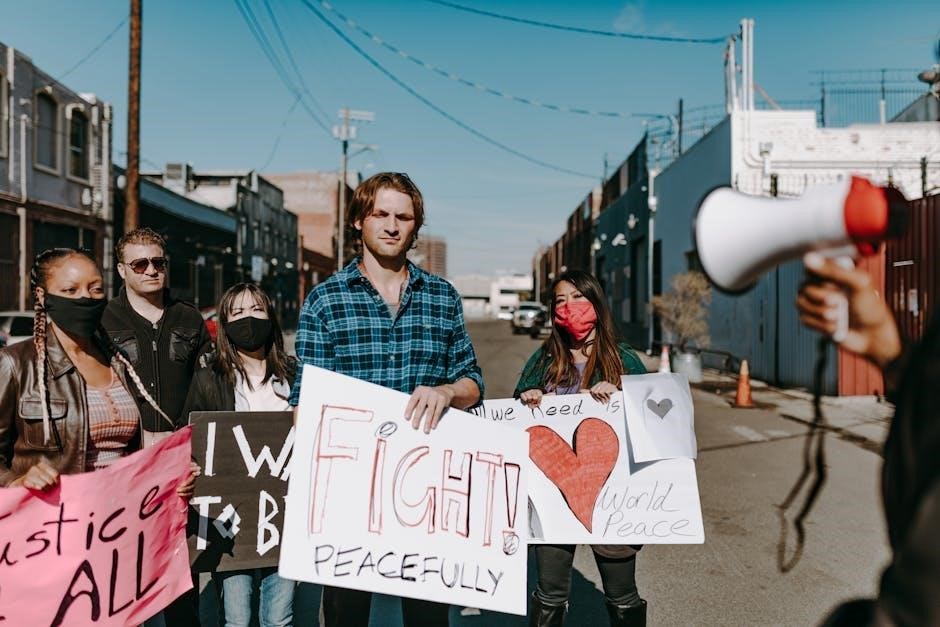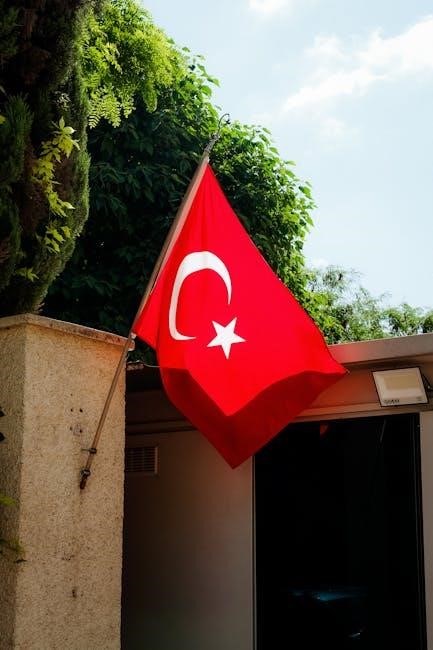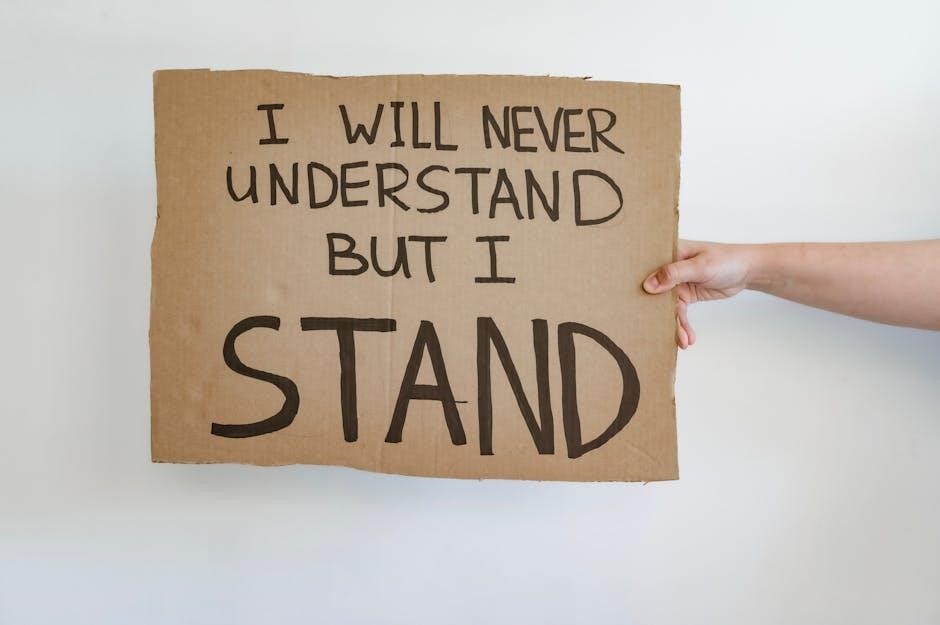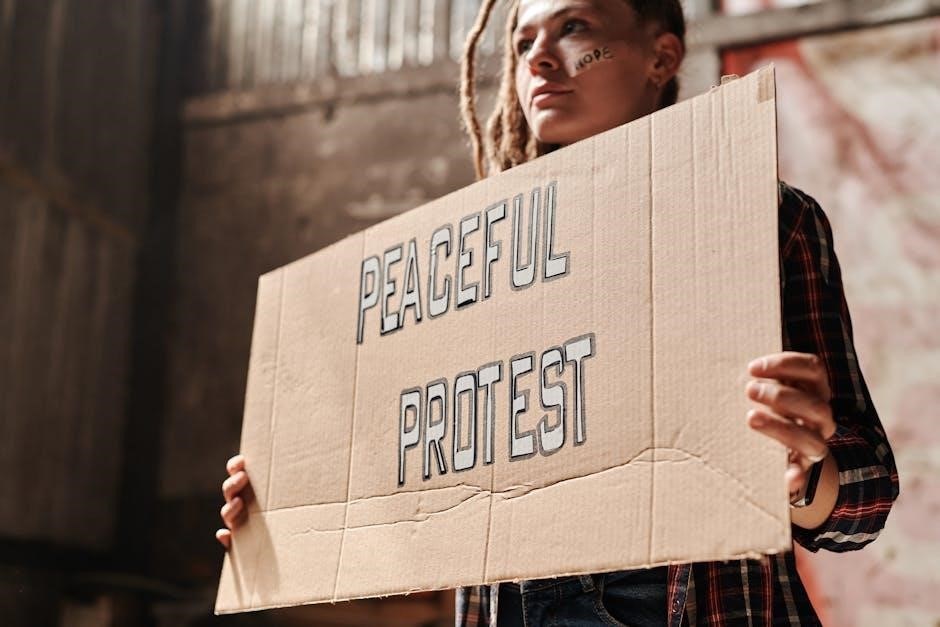Civil Peace, a short story by Chinua Achebe, explores post-Nigerian Civil War realities through Jonathan Iwegbu’s survival journey. It highlights resilience and the struggle to rebuild life amidst chaos, offering a gritty portrayal of peace after conflict.
Overview of the Short Story
Civil Peace, set after the Nigerian Civil War, follows Jonathan Iwegbu as he navigates post-war realities. The story explores survival, resilience, and the daily struggles of rebuilding life. Jonathan, despite losing much, finds hope in small victories, like his surviving family and a humble compound. Achebe’s narrative captures the essence of peace amidst chaos, highlighting the human spirit’s capacity to endure and rebuild.
Significance in African Literature
Civil Peace is a seminal work in African literature, reflecting post-colonial realities and the human condition. Chinua Achebe, celebrated as the father of African literature, captures the resilience of ordinary people amidst war’s aftermath. The story’s gritty realism and thematic depth provide insight into post-conflict society, solidifying its importance in understanding the African experience and the quest for peace in turbulent times.

Historical Context: Nigerian Civil War 1967-1970
The Nigerian Civil War (1967–1970) erupted after the southeastern region declared independence as Biafra. The conflict, marked by severe humanitarian crises, lasted three years, ending with Nigeria’s victory. It caused over a million deaths, widespread displacement, and economic devastation, profoundly shaping the nation’s identity and societal structures, as depicted in Civil Peace.
Causes and Key Events of the War
The Nigerian Civil War (1967–1970) was sparked by political instability, ethnic tensions, and disputes over resource distribution, particularly oil. The declaration of Biafra’s independence led to a brutal conflict, marked by a devastating blockade, widespread famine, and massive casualties. Key events included the Battle of Enugu and the fall of Biafra, resulting in immense human suffering and lasting societal scars that shaped Nigeria’s trajectory.
Impact on Nigerian Society
The Nigerian Civil War caused immense human suffering, with over a million deaths, mainly from starvation. It disrupted the economy, leading to widespread poverty and infrastructure destruction. Socially, it deepened ethnic divisions and displaced millions, creating long-term challenges for national unity. The war’s aftermath, as portrayed in Civil Peace, highlights the struggles of rebuilding communities and trust in a fractured society, underscoring the enduring scars of conflict.

Main Themes in “Civil Peace”
Civil Peace explores themes of survival, resilience, and the harsh realities of post-war life. It delves into the struggles of rebuilding and the enduring impact of conflict on individuals and society, highlighting the human spirit’s capacity to persevere amidst chaos and destruction, while also revealing the challenges of restoring normalcy after prolonged violence.
Survival and Resilience
Survival and resilience are central themes in Civil Peace, as Jonathan Iwegbu navigates the aftermath of the Nigerian Civil War. Despite losing everything, Jonathan remains resourceful and optimistic, exemplifying the human spirit’s ability to endure hardship. His determination to rebuild and provide for his family underscores the story’s focus on survival as a form of resistance and resilience in the face of overwhelming adversity and societal collapse.
Post-War Realities and Challenges
Civil Peace vividly portrays the harsh post-war realities faced by Nigerians, particularly Jonathan Iwegbu. The story highlights the struggle to rebuild lives amidst economic hardship, social disruption, and political instability. Jonathan’s experiences reflect the broader challenges of reconstructing communities, dealing with scarcity, and coping with the emotional toll of conflict, offering a poignant glimpse into the difficult transition from war to peace.
Character Analysis: Jonathan Iwegbu
Jonathan Iwegbu, the protagonist, embodies resilience and determination. His survival of the war and efforts to rebuild his life highlight his resourcefulness and strength in the face of adversity.
Character Development and Role in the Story
Jonathan Iwegbu evolves from a war survivor to a resilient individual determined to rebuild his life. His optimism and resourcefulness drive the narrative, showcasing his role as a symbol of hope amidst post-war challenges. Through his actions, Achebe highlights the human spirit’s capacity to endure and adapt, making Jonathan central to the story’s themes of survival and recovery.
Symbolism of Jonathan’s Experiences
Jonathan’s experiences symbolize the broader struggles of post-war Nigeria, reflecting the nation’s collective trauma and resilience. His survival and efforts to rebuild signify hope and the human spirit’s indomitable will. Through his journey, Achebe conveys the universal themes of recovery and the pursuit of normalcy, making Jonathan a powerful symbol of post-conflict resilience and societal renewal.

Literary Analysis of the Story
Civil Peace showcases Achebe’s mastery of storytelling, blending realism with emotional depth. His concise prose and vivid imagery highlight the harsh realities of war and peace, creating a compelling narrative that resonates deeply with readers.
Narrative Techniques and Style
Achebe employs a direct, unembellished prose style in Civil Peace, mirroring the stark realities of post-war life. His use of Jonathan’s first-person narrative creates immediacy, drawing readers into the character’s struggles. The story’s simplicity and emotional depth underscore the harsh truths of survival, resonating with universal themes of resilience and hope in the face of adversity.
Cultural and Social Commentary
In Civil Peace, Achebe blends Igbo cultural values with Christian influences, reflecting Nigeria’s post-colonial identity. The story critiques societal norms, highlighting the tension between traditional practices and modern aspirations. Achebe’s portrayal of Jonathan’s struggles underscores the broader social inequalities and the resilience of ordinary Nigerians, offering a poignant commentary on the human condition in post-war societies.
Legal and Non-Legal Forms of Civil Communication
Legal frameworks establish formal rules for dialogue, while non-legal strategies emphasize community initiatives and cultural exchange, fostering peace through mutual understanding and cooperation.
Legal Frameworks for Peace
Legal frameworks for peace provide structured mechanisms for dialogue and conflict resolution, ensuring accountability and enforcement. They often include treaties, agreements, and policies that govern interactions between states and societies. For instance, the Philippine peace agreement established the Bangsamoro Autonomous Region, demonstrating how legal structures can institutionalize peace processes and promote stability.
Non-Legal Strategies and Initiatives
Non-legal strategies emphasize community-driven approaches, fostering peace through dialogue, cultural exchange, and advocacy. NGOs and local groups play a crucial role, promoting reconciliation and awareness campaigns. For example, the Berghof Foundation focuses on preventing violence and achieving sustainable peace through non-legal initiatives, highlighting the importance of grassroots efforts in building harmonious societies.
Peace Agreements and Their Impact
Peace agreements, like the 2014 Philippine accord, establish frameworks for stability and reconciliation. They address conflicts’ root causes, fostering cooperation and long-term harmony among previously divided groups.
Case Studies of Successful Agreements
The 2014 Philippine peace agreement exemplifies a successful case, establishing the Bangsamoro Autonomous Region and reducing violence. It addressed historical grievances, fostering cooperation and stability. Similarly, post-conflict agreements in Nigeria, post-Biafra, emphasized reconciliation and reconstruction, highlighting the importance of inclusive frameworks in achieving lasting civil peace and societal healing.
Challenges in Implementing Peace Accords
Implementing peace accords faces hurdles like political resistance, resource scarcity, and societal mistrust; In Nigeria, post-war reconstruction struggled with corruption and inequitable distribution of resources, delaying recovery. Similarly, the Philippine agreement encountered challenges in disarmament and territorial disputes, underscoring the complexity of translating agreements into tangible, lasting peace, requiring sustained commitment and inclusive governance to overcome obstacles effectively.

Role of Civil Society in Achieving Peace
Civil society plays a crucial role in fostering peace through NGOs, community initiatives, and advocacy campaigns, rebuilding trust and promoting collective action to address social conflicts effectively.
Contributions of NGOs and Community Groups
NGOs and community groups play a vital role in fostering peace by facilitating dialogue, providing aid, and empowering local communities. They often act as mediators, bridging gaps between conflicting parties and promoting reconciliation. Through grassroots initiatives, these organizations address socio-economic disparities, rebuild infrastructure, and advocate for justice. Their efforts are essential in creating sustainable peace and rebuilding trust within divided societies, ensuring long-term stability and harmony.
Advocacy and Awareness Campaigns
Advocacy and awareness campaigns are crucial in promoting civil peace by educating communities about conflict resolution and social justice. Organizations like the Berghof Foundation use workshops, media, and public forums to foster dialogue and understanding. These initiatives highlight the importance of inclusivity and equality, empowering individuals to actively participate in peacebuilding efforts and creating a culture of non-violence and mutual respect within societies.
Cultural Influences on Concepts of Peace
Cultural influences shape peace concepts through traditional practices and modern approaches. Achebe’s work blends Igbo culture with Christian elements, reflecting diverse pathways to harmony and understanding.
Traditional Practices and Modern Approaches
Traditional practices, such as communal rituals and storytelling, provide a cultural foundation for understanding peace. Modern approaches integrate these practices with contemporary strategies, fostering a balanced path to harmony. Achebe’s work highlights the blend of Igbo traditions and Christian influences, illustrating how cultural values and modern ideologies can coexist to promote sustainable peace and societal healing.
Education and Cultural Exchange
Education plays a vital role in fostering peace by teaching historical lessons and promoting tolerance. Cultural exchange bridges societal divides, encouraging mutual understanding. In Civil Peace, Achebe’s narrative reflects the blending of Igbo traditions and external influences, showcasing how education and cultural dialogue can pave the way for reconciliation and lasting harmony in post-conflict societies.
Civil Peace remains timeless, offering lessons on resilience and rebuilding. Its gritty realism serves as a warning and inspiration, urging societies to pursue peace and unity amidst chaos.
Lessons from History
Civil Peace underscores the enduring resilience of humanity post-conflict. The story highlights survival strategies, communal rebuilding, and the importance of unity. It serves as a reminder of the human capacity to adapt and rebuild, offering timeless lessons on the value of perseverance and collective effort in achieving lasting peace and societal harmony.
Future Prospects for Civil Peace
Civil Peace highlights the potential for rebuilding and unity post-conflict. By fostering education, dialogue, and inclusive governance, societies can lay foundations for lasting peace. Lessons from history emphasize the importance of addressing root causes of conflict and promoting collective responsibility to ensure a harmonious future where civil peace is not just a goal but a sustainable reality.

